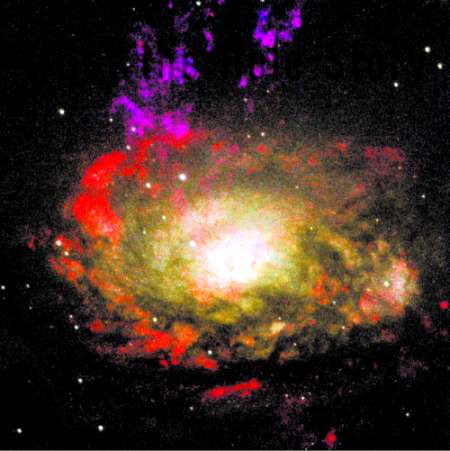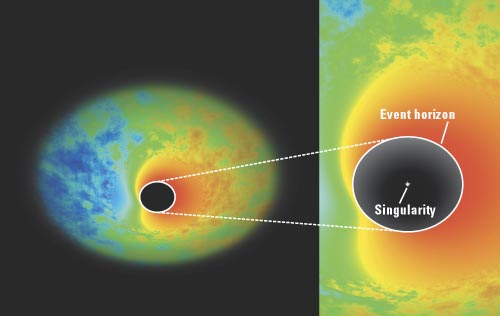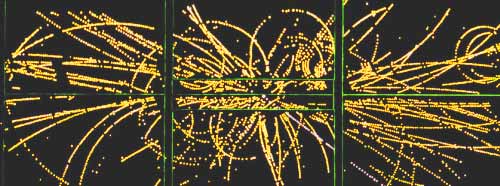Objects so dense that their gravitational attraction prevents matter and light from escaping them were first proposed in 1783 by the Englishman John Michell and again in 1795 by the Frenchman Pierre-Simon Laplace, as logical extrapolations of Newton’s laws of universal gravitation and corpuscular light. The Michell/Laplace “dark bodies” became footnotes in the history of science when Einstein showed that Newton’s law of gravitation was incorrect in the realm where matter becomes very dense and that his corpuscular theory of light was also flawed.
In their present incarnation, black holes were proposed in 1939 by J. Robert Oppenheimer and his collaborators based on the equations of Einstein’s General Theory of Relativity. These equations say that if matter becomes sufficiently concentrated, its gravitational attraction can overwhelm all other effects, creating regions from which matter and light can’t escape. The name black hole was first applied to these light-trapping regions by Princeton astrophysicist John Wheeler in 1967.
The boundary between a black hole and the rest of the universe is called the hole’s event horizon. However, no matter exists there. It is just a hypothetical shell at a distance from the black hole’s center determined by its mass. Anything crossing the event horizon can never return to the outside universe. If the matter that formed the black hole was not rotating, the hole’s mass would be concentrated at its center. In the far more likely event that the matter was rotating initially, its mass would form a ring inside its event horizon.
But do they really exist? We can’t see black holes directly because light can’t escape from them, but we can see their effects on surrounding matter, such as nearby gas and stars. Black holes have signature effects on other matter that are not duplicated by any other objects. Aided by images taken with Hubble and other powerful telescopes, astronomers over the past two decades have located an ever-growing number of black holes. Some are the collapsed cores of stars that began life with more than 8 solar masses and exploded, while the rest are much more massive and were probably created shortly after the Big Bang from vast collapsing clumps of gas around which galaxies coalesced. Such is the confidence in the observations of black holes that at the January 1997 American Astronomical Society meeting in Toronto, Canada, several astronomers predicted the existence of these so-called supermassive black holes in the centers of most of the billions of galaxies.
The recently discovered supermassive black holes at the centers of galaxies contain between a few million and a few billion times as much mass as the sun, making them by far the most massive individual objects in the known universe. In contrast, the stellar-core black holes range in mass between about 3 and 50 solar masses. British astrophysicist Steven Hawking has proposed a third, as yet undetected, type of black hole. Called primordial or “mini” black holes, these are believed to have formed at the beginning of time, when the Big Bang that created the universe supercompressed tiny amounts of matter. Tiny is relative, of course; the masses compressed into primordial black holes are believed to have ranged from fractions of a gram to the mass of a large planet.
Scientific understanding of black holes has exploded since the 1960s, when astrophysicists began studying them intensively. Filtered through science and science fiction writers, however, ideas about black holes still resonate false notions. Many people think that any black hole will grow so large that someday it will devour Earth. Movie and television portrayals of black holes as giant whirlpools or funnels add to the confusion. Other common misconceptions include believing that black holes are regions of empty space or “holes in space” and that they will last forever.
The problem of understanding black holes begins with their name. Black holes are not necessarily black nor are they holes. “Black” normally indicates the total absence of color and it is applied to black holes to mean the total absence of emitted light or other radiation. Large black holes are pretty much black. But smaller black holes can radiate energy. In 1974, Hawking proposed a mechanism by which black holes transform their mass into both radiation and particles that leave the vicinity of the hole. He asserted that small black holes thereby evaporate, glowing more brightly in the process.
The “Hawking process” of black hole evaporation works like this: All the time and throughout all space, pairs of particles are spontaneously created. They annihilate each other in such short times (typically in 10 to 23 seconds) that their presence does not violate any law of physics. Inside our bodies, for example, space is a seething foam of these “virtual” particles. We know these particles exist because they have been observed in high-energy particle accelerators: A rapidly moving real particle striking a pair of virtual particles before they annihilate each other, separates them from each other and makes them real.
Virtual particles created just outside a black hole’s event horizon can also become real. If one particle in such a pair is slightly closer to the event horizon than its companion, the black hole’s enormous gravitational force on the closer one will be so much greater than the force on the one farther away that the difference will rip them apart and make them real. The one closer to the hole always falls into it, but the one farther away often becomes real with enough outward speed so as to completely escape from the hole.
It may seem that a black hole should grow more massive due to the Hawking process, since it always pulls in at least one of the particles it creates. You can see that this doesn’t happen by adding up the mass it gains and loses: The gravitational energy used to make the particles real comes from the mass inside the black hole. The amount of mass converted into the gravitational energy that rips the virtual particles apart is given by Einstein’s mass-energy equation E = (2m)c², where 2m is the total mass of the two, newly formed particles. This gravitational energy passes out through the event horizon, and creates the two particles, shrinking the black hole’s mass by 2m. When only one particle falls back in, the black hole’s mass increased, but only by m, half the amount by which its mass decreased moments before. The net result is that the hole loses mass equal to the mass of the particle that escapes from it completely. As seen from far away, very small black holes appear to be radiating matter and electromagnetic radiation, all of which is actually created outside the event horizon. So not all black holes are black.
As a black hole shrinks, its event horizon gets closer and closer to its center. Interestingly, the equations reveal that the evaporation rate increases as the horizon shrinks, even though the hole’s mass is decreasing. Each black hole should vanish in a final, staggering burst of “Hawking radiation.” Astronomers are looking for these telltale explosions. So, black holes do not last forever. The time scales for completely evaporating a black hole are instructive. The smallest primordial ones evaporate in much less than a billion years. Those with the mass of a mountain should be dying just about now, some 14 billion years after the universe began. A black hole with the mass of the sun will vanish after about 1062 years, while the ones at galactic centers will take millions or billions of times longer.
Next, we consider why black holes really aren’t holes. Here, too, the words get in the way. My dictionary has 20 definitions of a hole; two are relevant. First, a hole is “a hollow place in a solid mass; a cavity.” This is the one many people associate with black holes: a cavity or void in space. But black holes are crammed full of highly condensed matter. They are not cavities.
The second relevant definition is “an opening through something; a gap.” While Einstein’s equations are equivocal about this, there is a consensus that black holes do not connect different regions of space like the “wormholes” we see depicted in science fiction films. Yes, but, a black hole is a place that is outside the regular universe. It is a hole or gap in the fabric of the universe. Besides the problems with the word “hole” just mentioned, black holes are not completely “outside” the universe. They communicate with the rest of it in three ways. First, the mass in the black hole creates precisely as much gravitational attraction on distant objects as it did before becoming a black hole. Second, the black hole’s angular momentum is the same as it was before its matter became a black hole and, indeed, its rotation affects the space just outside its event horizon in strange ways. Third, the net electric charge of all matter in the black hole (the difference between the number of positive and negative charges) is felt outside its event horizon just as it was before the charges entered the black hole.
So black holes are not holes, either. What about the truth of other popular beliefs? By far the most common one is that black holes are cosmic vacuum cleaners. For two reasons, black holes are actually less effective in drawing objects into themselves than was their mass before it became a black hole. First, stellar core black holes are so small that they can only consume a tiny volume of matter at any time. The event horizon of a 10 solar-mass black hole is only 10 miles from its center, while a 10 solar-mass star has a 20-million-mile radius. Consequently, black holes might gravitationally attract large volumes of gas (from a companion star, say), but the black hole is so small that the gas must spiral around it, sometimes for years, like water around a drain, waiting to get pulled in.
Second, the only way black holes can absorb matter is by their gravitational attraction. A star of the same mass can also use other physical effects to absorb matter. Consider a comet flying toward a 10 solar-mass star on a trajectory that would take it within a thousand miles of the star’s core, if it survived that long. The tremendous heat output of the star would evaporate the gases in the comet before impact, while the rock and metal in the comet would vaporize when it entered the star’s outer layers.
Now suppose the same comet flew on the same path toward a 10 solar-mass black hole. The gravitational attraction of the hole on the comet would be the same as that from the equivalent-mass star. Because the amount of Hawking radiation from a stellar black hole is minuscule compared to the output of a star, the black hole would not vaporize the approaching comet. Furthermore, the hole is so small that the comet’s closest approach would be 985 miles from the event horizon. At that distance, the hole’s gravity would act as gravity from a normal object, causing the comet to change direction as it passed. The comet would swing past the black hole and depart in a new direction, without having been gobbled up or destroyed as it was by the star. At worst, the gravitational force on the comet’s solid body (its nucleus) would be strong enough to tear it apart by creating tides on it like the moon creates on Earth. But the comet would survive the passage either intact or in a few pieces. Even billion solar-mass galactic black holes only act gravitationally on the rest of the universe; astronomers see gas and stars orbiting around such bodies, without being sucked in. So black holes have no magical ability to suck in external matter and – regardless of what else happens – one is not going to grow and eventually swallow Earth.
However, black holes do show some weird effects on space very close to them. The distance from the center of the black hole to its event horizon is called the Schwarzschild radius. All the weird effects from black holes occur within about ten Schwarschild radii of the center of the hole. Beyond that rather limited distance, the only effect of the black hole on other objects is via the hole’s normal gravitational attraction, just discussed.
The most bizarre misconceptions about black holes I have encountered are those created by some theologies either to intimidate young children or to explain black holes in religious contexts. While interviewing college students about their beliefs about black holes prior to taking a college astronomy course, I was astonished to learn that several of them had been threatened by their religious leaders or religiously oriented parents with being “sent into” a black hole if they misbehaved. This has the double effect of intimidating the child and associating science with evil. Other students were told that black holes are places where the souls of as-yet-unborn children reside.
While astrophysicists have accumulated an impressive body of knowledge about the true nature of black holes, we don’t yet know everything there is to know about them. Most of our ignorance centers around the nature of the matter that collapses into the hole. It becomes so densely packed that none of our current physical theories are adequate to explain it.
What needs to be done – essentially one of the holy grails of modern physics – is to combine general relativity with the theory of matter called quantum mechanics, which has brought us computer chips and lasers, among other things. Called quantum gravity, physicists expect this new theory to provide deep insights not only into black holes, but also into the state of matter just after the universe formed. And who knows — it might bring knowledge we can even apply in the coming millennium.












